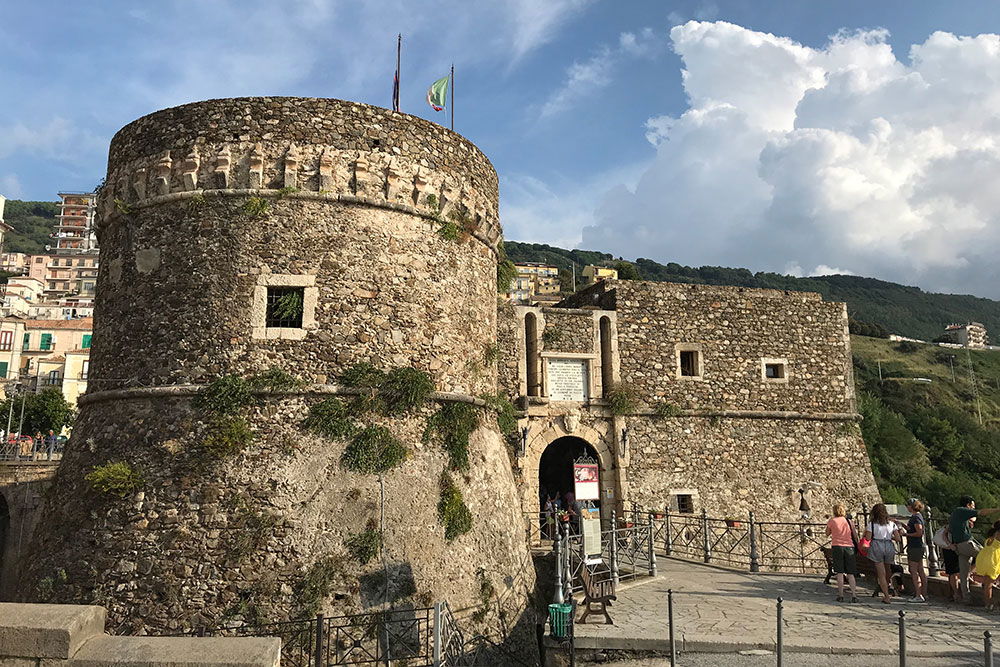
Perched on a rocky outcrop above the shimmering Tyrrhenian Sea, Castello Murat in Pizzo Calabro, Calabria, is more than just a scenic coastal fortress. It’s a place where military strategy, royal ambition, and political intrigue collided in dramatic fashion. Named after Joachim Murat, King of Naples and Napoleon Bonaparte’s brother-in-law, the castle is both a historical monument and a symbol of a tragic downfall.
Originally constructed in 1492 by the Aragonese during their rule over southern Italy, Castello Murat was designed to defend the Calabrian coast from Saracen and pirate attacks. With its thick stone walls, semi-circular bastions, and panoramic position overlooking the Gulf of Saint Euphemia, it served both as a military fortress and a lookout point.
Throughout its history, the castle has been modified by successive rulers, from the Spanish to the Bourbons, but it retained its strategic importance thanks to its ideal location in Pizzo, a fishing town known for its maze-like historic center, artisan gelato (especially tartufo di Pizzo), and sweeping sea views.
The name “Castello Murat” comes from its most famous prisoner, Joachim Murat, Napoleon’s flamboyant and charismatic cavalry commander who became King of Naples in 1808. Murat had married Napoleon’s sister Caroline and ruled southern Italy for several years, attempting to modernize the kingdom with reforms inspired by French ideals.
After Napoleon’s fall in 1815, Murat tried to regain his throne, believing he could ignite a rebellion in southern Italy. However, his attempt failed spectacularly. He landed at Pizzo with a small force, expecting local support, but was instead captured by Bourbon loyalists and imprisoned in the very fortress that would bear his name.
The events of October 13, 1815, remain etched in history. Joachim Murat was hastily tried by a military tribunal and sentenced to death. He spent his last hours in a small, cold cell inside the castle, writing letters to his wife and children. On the morning of October 13th, he faced the firing squad with pride and defiance, refusing a blindfold and giving the soldiers the order to fire himself.
His dramatic last words, said to be “Soldiers! Do your duty. Aim at my heart. Spare the face!”, turned him into a romantic and tragic figure, immortalized in European memory.
Today, Castello Murat is a museum and historical site that attracts thousands of visitors each year. Its rooms and corridors have been restored to tell the story of Murat’s final days and the broader history of Pizzo.
Inside, you can explore:
The atmosphere is evocative, with dim lighting and original stonework that create a solemn and reflective experience. It’s a unique blend of military architecture and poignant storytelling, offering an immersive dive into one of Italy’s most dramatic historical episodes.
As with many historical sites in Italy, legends swirl around Castello Murat. Some locals claim that the ghost of Joachim Murat still walks the fortress halls, especially on stormy nights. Others believe that buried documents or treasure from his short reign may still lie hidden within the stone walls.
Whether or not you believe the stories, there’s no denying that the castle has a powerful aura, especially at sunset when golden light pours through the ancient battlements and the sea below glistens with mystery.
Located in the heart of Pizzo’s historic center, the castle is easy to reach on foot from the town’s main square. Opening hours vary seasonally, but it's typically open daily during the warmer months, with guided tours available in multiple languages.
Admission is modest, and tickets support the ongoing preservation of this important historical site.
Before or after your visit, wander down into the town for some local seafood or enjoy a famous tartufo gelato at one of Pizzo’s iconic gelaterias. The combination of culture, history, and cuisine makes a day in Pizzo an unforgettable experience.
Castello Murat is more than just a castle, it’s a living chapter of Italian and European history. From its military origins to its association with a fallen king, the fortress offers insight into the dramatic power struggles of the 19th century, while also showcasing the charm of Calabria’s Tyrrhenian coast.
A visit here connects you not only to the past, but also to the soul of southern Italy, a place where beauty and tragedy are often intertwined, and where every stone tells a story.

More Details



